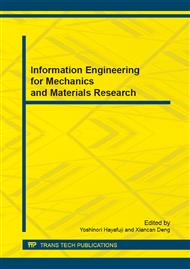[1]
L. Costa, L. R. Montelera, G. Camino, E. D. Weil, E. M. Pearce, Structure-charring relationship in phenol-formaldehyde type resins, Polym. Degrad. Stab. 56 (1997) 23-35.
DOI: 10.1016/s0141-3910(96)00171-1
Google Scholar
[2]
C.P. Reghunadhan Nair, R.L. Bindu, K.N. Ninan, Thermal characteristics of addition-cure phenolic resins, Polym. Degrad. Stab. 73 (2001) 251–257.
DOI: 10.1016/s0141-3910(01)00076-3
Google Scholar
[3]
E. FITZER and W. SCHAFER, The effect of crosslinking on the formation of glasslike carbons from thermosetting resins, Carbon 8 (1970) 353-364.
DOI: 10.1016/0008-6223(70)90075-8
Google Scholar
[4]
Young Jeon Kim, Myung Il Kim, Chang Hun Yun, Ji Young Chang, Chong Rae Park and Michio Inagaki, Comparative study of carbon dioxide and nitrogen atmospheric effects on the chemical structure changes during pyrolysis of phenol-formaldehyde spheres, J. Colloid Interface Sci. 274 (2004).
DOI: 10.1016/j.jcis.2003.12.029
Google Scholar
[5]
KRYSTYNA ROCZNIAK, TERESA BIERNACKA and MACIEJ, Some Properties and Chemical Structure of Phenolic Resin and Their Derivatives, J. Appl. Polym. Sci. 28 (1983) 531-542.
DOI: 10.1002/app.1983.070280209
Google Scholar
[6]
L.B.Manfredi,O. de la Osa,N. Galego Fernandez,A. Vazquez, Strucutre-properties relationship for resols with different formaldehyde/phenol molar ratio, Polymer 40 (1999) 867-3875.
DOI: 10.1016/s0032-3861(98)00615-6
Google Scholar
[7]
Kimberly, A. Trick and Tony E. Saliba, Mechanism of the pyrolysis of phenolic resin in a carbon/phenolic composite, Carbon 33 (1995) 1509-1515.
DOI: 10.1016/0008-6223(95)00092-r
Google Scholar
[8]
K. A. Trick, T. E. Saliba and S.S. Sandhu, A kinetic model of the pyrolysis of phenolic resin in a carbon / phenolic composite, Carbon 35 (1997) 393-401.
DOI: 10.1016/s0008-6223(97)89610-8
Google Scholar
[9]
WILLIAM M, JACKSON and ROBER T. COKLEY. High Temperature Oxidative Degradation of Phenol-Formaldehyde Polycondensates, J. Appl. Polym. Sci. 8 (1964) 2163-2193.
DOI: 10.1002/app.1964.070080516
Google Scholar
[10]
J.A. Parker and E.L. Winkler, NASA TR R-276, Ames. Research Center, (1967).
Google Scholar
[11]
K. Quchi and H. Hond, Fuel 38 (1959) 429-431.
Google Scholar
[12]
C. Morterra, M.J.D. Low, Low I.R. Studies of Carbons-Ⅶ The pyrolysis of A phenolic- formaldhyde resin, Carbon 23 (1985) 525-530.
DOI: 10.1016/0008-6223(85)90088-0
Google Scholar
[13]
Golfarb, IJ, et al. Helminiak TE Park Ridge(NS). Noyes Data Corporation, (1987).
Google Scholar
[14]
Marie-Florence Grenier-Loustalot, Stbphane Larroque and Philippe Grenier, Phenolic resins: 5. Solid-state physicochemical study of resoles with variable F/P ratios, Polymer 37 (1996) 639-650.
DOI: 10.1016/0032-3861(96)83151-x
Google Scholar


